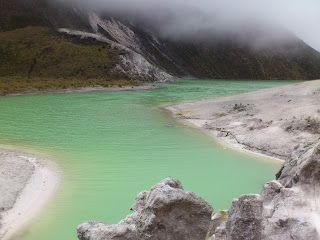People here look all very “Andean” with their black hair, their pony tails (men and women),their folk clothing, the mothers with kids wrapped behind their back and their petite figure (they are all short , very short.... I mean we look tall here!!!!)
The loud sound of salsa and merengue has also been replaced by a much more sedated sound of pan flutes.
Some of the elderly people don’t speak Spanish, instead they use their own language (I guess quechua ?)
I wouldn’t say that Ecuadorian are less friendly than Colombian, but certainly the feeling is that they tend to be a bit more “reserved” (a lady at the market threw me a bean today when I tried to take a picture of her stall)
On the other hand we feel that as a nation Ecuador is a little bit wealthier than Colombia and certainly you can find luxury goods in the shops on the high street that we did not see in Colombia.
The use of mobile phones for example is wide spread across the population over here (today at the market I saw an old lady farmer selling chickens, taking not 1 but 2 mobiles out of her purse when she heard them ringing), whereas in Colombia the majority of the population would still rent them in the streets and pay the usage by the minute at the ever so present “minutes” stalls.
We arrived in Otavalo on the 25th of August and found accommodation at the Rivera Sucre Hotel right in the centre of town.
Our room is huge with 2 double beds and plenty of furniture, private bathroom and 4 windows facing a lovely garden.
The hotel comes with a Patio (where the owner has allowed me to park my bike after riding it through the entrance hall) a huge kitchen that we are free to use and even a game room.
All of the above available to us for the “extortionate” price of £15 per night!!!!
In fact strangely enough, even though Ecuador is wealthier than Colombia, everything that the tourist needs is actually cheaper (food, accommodation, petrol etc)
We were a bit disappointed to read on the Lonely Planet that we were too early to witness the most important celebration of the year: The fiesta de Yamor, held in Otavalo the first 2 weeks of September.
In reality we soon found out with great relief that the Lonely was wrong and the celebration had started on the 20th of August.
Most importantly we had just arrived in town to witness the Parade: 92 dance groups competing in a 4 hour parade from 7pm to 11pm.
For the day the Calle Bolivar (the main road in town) is closed to the traffic. The owners of the shops place strategically chairs on the pavements in front of their shops that are rented at $2.5 to the spectators that want to watch the show sitting in prime location.
We were just about to fork out our fiver when a lovely lady invited us to sit on the chairs in front of her shop for free.We still don’t know why she did it. The 2 most accredited theories are:
Elena’s theory = she was nice and wanted to impress 2 tourists
Paolo’s theory = because we are very tall and extremely good looking (in Otavalo at least) and Elena is also blonde with blue eyes (totally unique features over here) , the lady thought she would use our powerful image to improve the look of her shop and attract the local TV filming the parade.
We will never know. The great news is that the show was absolutely brilliant, we were sitting in front of the standing crowd, at 1 meter from the action, we had free popcorns too and yes, the local TV came to film us!!
The only regret is that the following day, while transferring pictures and movies from my mobile to the PC I accidentally deleted 90% of the movies.....doh!




















































